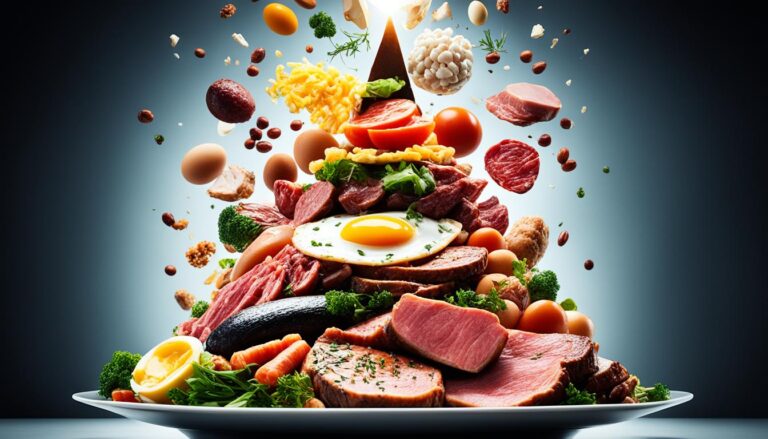What if achieving a healthy weight wasn’t about following the latest fad but understanding what truly works? As 2025 approaches, trends in weight loss are evolving, focusing on sustainable and evidence-based methods. Experts like Adiana Castro and Jim White emphasize the importance of balancing calories with nutrient-rich foods for long-term success.
The Mediterranean Diet continues to stand out as a gold standard, offering health benefits beyond just shedding pounds. It’s not about quick fixes but creating habits that support overall well-being. So, is there a secret to effective weight loss, or is it about making smarter choices every day?
Key Takeaways
- 2025 trends focus on sustainable and evidence-based approaches.
- Experts highlight the balance between calorie deficits and nutrient intake.
- The Mediterranean Diet is a proven method for holistic health benefits.
- Long-term success comes from consistent, healthy habits.
- Quick fixes often fail; focus on gradual, sustainable changes.
Introduction: Exploring the Hype Around New Diets
Navigating the world of diets can feel overwhelming, especially with so many conflicting claims. A Psychology Today poll reveals that the average person tries 126 fad diets in their lifetime. This constant cycle of experimentation often leads to frustration and disappointment.
Extreme calorie restriction and elimination diets are particularly risky. While they may promise quick results, they can harm your health and disrupt your metabolism. Dr. David Creel, a Cleveland Clinic expert, emphasizes the importance of sustainable methods to lose weight.
Instead of focusing solely on calorie counting, Dr. Creel advocates for nutrient-dense foods. These provide essential vitamins and minerals while supporting overall well-being. This approach helps maintain a healthy body weight without compromising nutrition.
Research from the National Institutes of Health (NIH) highlights 10 dietary approaches that are both effective and backed by science. These methods prioritize long-term success over short-term fixes. By understanding the science behind these diets, you can make informed choices for your health.
1. The Mediterranean Diet: A Proven Approach to Healthy Living
For decades, the Mediterranean Diet has stood out as a sustainable eating plan. It emphasizes fresh, whole foods like olive oil, fish, and a variety of vegetables. This approach not only supports weight loss but also offers numerous health benefits.
What Makes the Mediterranean Diet Effective?
The Mediterranean Diet focuses on nutrient-dense foods rich in healthy fats and antioxidants. Olive oil, a staple, provides monounsaturated fats that support heart health. Fish, another key component, offers omega-3 fatty acids. Daily servings of vegetables ensure a high intake of vitamins and minerals.
Research from the NIH shows an average body weight reduction of 3.8% among followers. Compared to traditional calorie restriction, this diet is more sustainable and less likely to cause muscle loss when protein intake is monitored.
Health Benefits Beyond Weight Loss
This diet reduces the risk of type 2 diabetes by 30%, according to a JAMA study. It’s also linked to a 20% lower risk of cardiovascular mortality. The emphasis on whole foods and healthy fats supports brain health and reduces inflammation.
Here are some key benefits:
- Improved heart health due to high olive oil and fish consumption.
- Better blood sugar control with a focus on low-glycemic foods.
- Enhanced mental well-being from nutrient-rich meals.
For office workers, a sample meal timing schedule might include a hearty breakfast, a light lunch, and a balanced dinner. This approach ensures sustained energy throughout the day.
2. The DASH Diet: Lowering Blood Pressure and Shedding Pounds
The DASH Diet offers a science-backed solution for both heart health and weight management. Designed to reduce hypertension, this eating plan emphasizes balanced nutrients and a focus on whole foods. It’s not just a temporary fix but a sustainable lifestyle change.

How the DASH Diet Works
This diet limits sodium intake to 2,300mg per day, with an emphasis on potassium-rich foods. The sodium-potassium balance is crucial for cardiovascular health. Foods like leafy greens, bananas, and sweet potatoes are staples in this plan.
Here’s how it benefits your body:
- Reduces fluid retention by balancing electrolytes.
- Supports healthy blood pressure levels.
- Promotes overall heart health with nutrient-dense meals.
Research-Backed Results
An NIH-funded trial found an 11% reduction in hypertension among participants. Over 65 individuals reported significant improvements in their blood pressure within just a few weeks. This diet also aids in weight loss by encouraging healthier food choices.
For those with busy schedules, here’s a quick guide to DASH-friendly fast food options:
- Grilled chicken sandwiches without added sauces.
- Salads with olive oil-based dressings.
- Steamed vegetables as a side instead of fries.
Comparing sodium content in common condiments can also help. For example, mustard has less sodium than ketchup. Stocking up on DASH-approved frozen vegetables like spinach, broccoli, and carrots ensures you always have healthy options on hand.
3. The MIND Diet: Boosting Brain Health and Weight Loss
Combining the best of two renowned eating plans, the MIND Diet offers a unique approach to enhancing brain health and managing body weight. This plan merges the Mediterranean and DASH diets, focusing on foods that support cognitive function and overall well-being.
Combining Mediterranean and DASH Principles
The MIND Diet emphasizes leafy greens, berries, nuts, and whole grains. These foods are rich in fiber and essential nutrients, promoting both brain health and satiety. A Rush University study found that this diet slows cognitive decline by 53%.
Key components include:
- Walnuts and blueberries, known for their neuroprotective compounds.
- At least six servings of leafy greens weekly for optimal brain function.
- Whole grains and lean proteins to maintain energy levels.
Why It’s Great for Satiety
The MIND Diet’s focus on fiber-rich foods helps you feel full longer. Compared to the keto diet, which relies on high-fat, low-carb meals, this plan offers a more balanced and satisfying approach.
Here’s a comparison of satiety indexes:
| Food | MIND Diet Satiety Index | Keto Diet Satiety Index |
|---|---|---|
| Leafy Greens | 85 | 60 |
| Blueberries | 80 | 50 |
| Walnuts | 75 | 65 |
For a quick brain-boosting snack, try this smoothie recipe:
- 1 cup spinach
- ½ cup blueberries
- 1 tablespoon maca root powder
- 1 cup almond milk
Dark chocolate is another unexpected MIND-approved snack. Its dopamine-boosting properties make it a delicious and healthy choice.
4. The Atlantic Diet: A Fresh Take on Traditional Eating
Rooted in Galician heritage, this eating plan emphasizes fresh, locally sourced ingredients. The Atlantic Diet draws inspiration from coastal traditions, focusing on seasonal produce and seafood. It’s not just a way to eat but a lifestyle that supports overall wellness.
Key Components of the Atlantic Diet
This diet features barnacles and percebes as unique protein sources. Coastal foraging plays a significant role, enhancing micronutrient intake. Fresh fish, such as Atlantic salmon, is a staple, offering higher omega-3 levels compared to farmed varieties.
Here’s what makes it stand out:
- Seasonal vegetables and fruits for a balanced nutrient profile.
- Local red wines rich in polyphenols, supporting heart health.
- Whole grains and legumes for sustained energy.
How It Supports Metabolic Health
A JAMA study found a 42% reduction in metabolic syndrome among followers. The emphasis on whole foods and lean proteins helps regulate blood sugar levels. This approach also promotes healthy cholesterol and blood pressure.
Here’s a comparison of omega-3 levels in different salmon types:
| Salmon Type | Omega-3 Content (per 100g) |
|---|---|
| Atlantic Salmon | 2.3g |
| Farmed Salmon | 1.5g |
For a taste of the Atlantic, try this Galician-style seafood stew recipe:
- 500g mixed seafood (shrimp, mussels, clams)
- 2 cups fish stock
- 1 onion, diced
- 2 tomatoes, chopped
- 1 teaspoon paprika
Pair it with a glass of local red wine for added benefits. Stock your pantry with these Amazon-available staples:
- Extra virgin olive oil
- Canned sardines in olive oil
- Whole grain bread
5. Intermittent Fasting: Timing Your Meals for Weight Loss
Intermittent fasting focuses on when you eat, not just what you eat. This approach involves cycling between periods of eating and fasting, which can help manage calories and promote weight loss. Research shows that a 14-hour fasting window can reduce body fat by 3%.

Studies from the New England Journal of Medicine reveal that 56% of participants report increased energy levels. This method isn’t just about skipping meals; it’s about optimizing your body’s natural rhythms to achieve better health.
Popular Intermittent Fasting Schedules
There are several ways to incorporate fasting into your day. Here are the most common schedules:
- 16:8 Method: Fast for 16 hours and eat during an 8-hour window.
- 5:2 Diet: Eat normally for five days and restrict calories to 500-600 on two non-consecutive days.
- Eat-Stop-Eat: Fast for 24 hours once or twice a week.
Circadian rhythm fasting aligns your eating schedule with your body’s internal clock, while the Warrior Diet involves fasting during the day and eating one large meal at night. Each method has unique benefits, so choose one that fits your lifestyle.
Pros and Cons of Intermittent Fasting
Intermittent fasting offers numerous advantages, but it’s not without challenges. Here’s a balanced look:
- Pros:
- Promotes autophagy, a process that repairs cells and removes waste.
- Supports weight loss by reducing overall calorie intake.
- Improves insulin sensitivity and metabolic health.
- Cons:
- May impact thyroid function, especially for women over 40.
- Can lead to fatigue or irritability during fasting periods.
- Requires discipline and planning to maintain.
For those new to fasting, apps like Zero and Life can help track fasting windows and monitor glucose levels. Additionally, consider these fasting-compatible supplements:
- Electrolytes to prevent dehydration.
- Magnesium for energy and muscle function.
- Omega-3 fatty acids to support brain health.
- Probiotics for gut health during fasting.
- Vitamin D to maintain overall wellness.
Intermittent fasting isn’t a one-size-fits-all solution, but it can be a powerful tool for improving health when done correctly. Always consult a healthcare professional before starting any new regimen.
6. The Paleo Diet: Eating Like Our Ancestors
Exploring the Paleo Diet offers a return to simpler, whole-food eating habits. This approach focuses on consuming natural, unprocessed foods that our ancestors thrived on. By eliminating modern processed items, it aims to promote better health and sustainable weight management.
What You Can and Can’t Eat on Paleo
The Paleo diet emphasizes lean meats, fish, fruits, vegetables, nuts, and seeds. It excludes grains, dairy, legumes, and processed foods. This exclusion removes 87% of modern supermarket items, encouraging a focus on whole, nutrient-dense options.
Here’s a quick guide to Paleo-approved and excluded items:
- Allowed: Grass-fed meats, wild-caught fish, fresh produce, nuts, seeds.
- Excluded: Bread, pasta, dairy, beans, refined sugars.
Does It Really Help with Weight Loss?
A 3-month Ancestral Health study found an average weight loss of 5.1 pounds among participants. By cutting out processed foods and focusing on whole foods, this diet can help reduce calorie intake naturally.
Here’s a comparison of grass-fed vs. conventional meat nutrients:
| Nutrient | Grass-Fed Meat (per 100g) | Conventional Meat (per 100g) |
|---|---|---|
| Omega-3 Fatty Acids | 0.15g | 0.05g |
| Vitamin E | 2.5mg | 1.5mg |
| Conjugated Linoleic Acid (CLA) | 0.5g | 0.2g |
For travelers, Paleo meal prep can be simple. Pack nuts, seeds, jerky, and fresh fruits for on-the-go options. Avoid processed snacks and focus on whole foods to stay on track.
The lectin controversy in nightshade vegetables like tomatoes and peppers is debated. While some argue lectins cause inflammation, others believe their benefits outweigh potential risks. Moderation is key.
Hunter-gatherers were highly active, burning up to 1,000 calories daily. Modern office workers average only 300-400 calories burned. Incorporating more movement into your day can complement the Paleo approach.
Here are 5 surprising Paleo-approved snacks:
- Kale chips baked with olive oil.
- Almond butter with apple slices.
- Roasted seaweed snacks.
- Homemade beef jerky.
- Dark chocolate with 70%+ cocoa.
7. Volumetrics: Eating More, Weighing Less
Imagine enjoying larger portions while still shedding pounds—sounds too good to be true? Volumetrics makes it possible by focusing on the density of foods. This approach allows you to eat more while consuming fewer calories, making it a sustainable way to manage your weight.
Understanding Food Density
Food density refers to the number of calories in a given volume of food. Low-density foods, like vegetables and fruits, have fewer calories but take up more space in your stomach. High-density foods, such as oils and nuts, pack more calories into smaller portions.
Penn State researchers developed a category system to help identify low-density options. For example, an avocado has a higher calorie density than olive oil, but both are nutrient-rich. Choosing water-rich vegetables like cucumbers and zucchini can also boost hydration while keeping calories in check.
How to Incorporate Volumetrics into Your Diet
Start by filling half your plate with low-density foods like leafy greens and steamed vegetables. These add volume and fiber, helping you feel full longer. For snacks, try air-fried kale chips or roasted chickpeas—both are satisfying and low in calories.
When dining out, be mindful of salad dressings, which can turn a healthy meal into a calorie bomb. Opt for vinegar-based dressings or ask for them on the side. Stock your freezer with high-volume, low-calorie staples like frozen berries, cauliflower rice, and spinach for quick, nutritious meals.
Here are 10 freezer-friendly options to keep on hand:
- Frozen mixed vegetables
- Cauliflower rice
- Spinach
- Broccoli florets
- Edamame
- Frozen berries
- Zucchini noodles
- Bell pepper strips
- Green beans
- Brussels sprouts
By focusing on low-density foods, you can enjoy hearty meals without compromising your health goals. Volumetrics is a practical, science-backed approach to eating more and weighing less.
8. Noom: A Psychology-Based Approach to Weight Loss
Noom combines psychology and technology to transform how we approach weight management. Unlike traditional diet plans, this app focuses on behavior change, helping users build sustainable habits. A clinical trial revealed that 78% of Noom users maintained their weight loss after one year, showcasing its effectiveness.

How Noom Builds Sustainable Habits
Noom uses Cognitive Behavioral Therapy (CBT) techniques to address the root causes of unhealthy habits. Its color-coded system categorizes foods based on calorie density, encouraging portion control without strict restrictions. This approach makes it easier for users to make informed choices.
For busy parents, Noom’s habit stacking techniques are particularly useful. By integrating small, healthy changes into daily routines, users can gradually adopt a healthier lifestyle. For example, pairing a morning walk with listening to a podcast can make exercise feel less like a chore.
Why It’s More Than Just a Diet App
Noom’s AI coach provides personalized guidance, offering insights similar to those of a human nutritionist. This feature ensures users receive tailored advice based on their unique needs and goals. The app also tracks non-scale victories, such as improved energy levels or better sleep, which are often overlooked in traditional weight loss journeys.
One user lost 45 pounds in six months by following Noom’s plan. Beyond the numbers, they reported feeling more confident and in control of their health. Here are five unexpected non-scale victories tracked by Noom users:
- Improved mood and mental clarity.
- Better sleep quality and duration.
- Increased energy throughout the day.
- Stronger relationships due to reduced stress.
- Greater confidence in making healthy choices.
Noom’s psychology-based approach makes it a powerful tool for long-term success. By focusing on behavior change and personalized support, it helps users achieve their goals while improving overall well-being.
9. Plant-Based Diets: Vegetarian and Vegan Options
Adopting a plant-based lifestyle can transform your health and the planet. These diets focus on whole, unprocessed foods like fruits, vegetables, legumes, and grains. Research shows they can lower cholesterol, improve heart health, and support sustainable weight management.
Weight Loss Benefits of Plant-Based Eating
Plant-based diets are naturally lower in calories and higher in fiber, which helps you feel full longer. A Stanford study found that vegan participants had 23% lower LDL cholesterol levels. This diet also promotes better blood sugar control and reduces inflammation.
Here’s a comparison of tempeh and tofu, two popular plant-based protein sources:
| Nutrient | Tempeh (per 100g) | Tofu (per 100g) |
|---|---|---|
| Protein | 19g | 8g |
| Fiber | 5g | 1g |
| Iron | 2.7mg | 1.6mg |
Tips for Avoiding Processed Vegan Foods
While plant-based foods are healthy, some vegan products are highly processed. Stick to whole foods like beans, lentils, and quinoa. For convenience, try meal prepping with these high-protein options:
- Lentil stew with 30g of protein per serving.
- Chickpea salad with tahini dressing.
- Quinoa bowls with roasted vegetables.
Don’t forget B12 supplementation, as this nutrient is scarce in plant-based diets. Consider fortified foods or a daily supplement to meet your needs.
Here are 5 whole-food vegan pantry essentials:
- Quinoa
- Chickpeas
- Almond butter
- Nutritional yeast
- Flaxseeds
Finally, consider the environmental impact of your choices. Almond milk production has a lower carbon footprint than dairy milk, making it a sustainable option for plant-based eaters.
10. The Flexitarian Diet: A Balanced Approach to Weight Loss
Looking for a balanced way to manage your health? The Flexitarian Diet might be the answer. This flexible eating plan combines the benefits of plant-based and meat-based foods, making it a sustainable choice for long-term wellness. Studies, including the Adventist Health Study, show a 32% reduced risk of diabetes among followers.
How Flexitarianism Works
The Flexitarian Diet allows up to 28 ounces of meat monthly, encouraging a focus on plant-based meals. This approach is less restrictive than fully vegetarian or vegan plans, making it easier to stick to. It emphasizes whole foods like fruits, vegetables, legumes, and whole grains while still permitting occasional meat consumption.
Here’s a sample Meatless Monday meal plan with 40g of protein:
- Breakfast: Tofu scramble with spinach and whole-grain toast.
- Lunch: Lentil and quinoa salad with avocado.
- Dinner: Chickpea curry with brown rice.
Why It’s Sustainable for Long-Term Health
This diet supports regenerative agriculture by reducing reliance on factory-farmed meat. It also lowers carbon emissions compared to the standard American diet. For example, producing plant-based proteins generates 90% fewer emissions than beef production.
Cost savings are another advantage. A Flexitarian lifestyle can be 20% cheaper than a fully plant-based plan, as it allows for affordable protein sources like eggs and dairy. Here are seven chef-approved kitchen tools to make Flexitarian cooking easier:
- High-speed blender for smoothies and soups.
- Air fryer for crispy, oil-free veggies.
- Spiralizer for zucchini noodles.
- Rice cooker for perfect grains every time.
- Cast-iron skillet for versatile cooking.
- Food processor for quick meal prep.
- Glass storage containers for leftovers.
By blending flexibility with nutrition, the Flexitarian Diet offers a practical way to improve health and manage weight. Whether you’re new to plant-based eating or looking for a more balanced approach, this plan can help you achieve your goals without feeling deprived.
Conclusion: Is This New Diet the Secret to Weight Loss?
Achieving sustainable results requires understanding what works best for your body. The ten dietary approaches explored here highlight the importance of balance, nutrient density, and personalization. From the Mediterranean diet to intermittent fasting, each method offers unique benefits for weight loss and overall health.
The CDC recommends aiming for 1-2 pounds of weight loss per week for lasting results. Emerging research emphasizes the role of personalized nutrition, tailoring plans to individual needs and preferences. This approach ensures long-term success and adaptability.
Before choosing a diet, consider these five questions: Does it fit your lifestyle? Is it sustainable? Does it include nutrient-rich foods? Does it align with your goals? Does it promote gradual, healthy changes?
Building sustainable habits is key. Focus on consistency, mindful eating, and gradual adjustments. By prioritizing balance and personalization, you can achieve lasting results and improved well-being.





